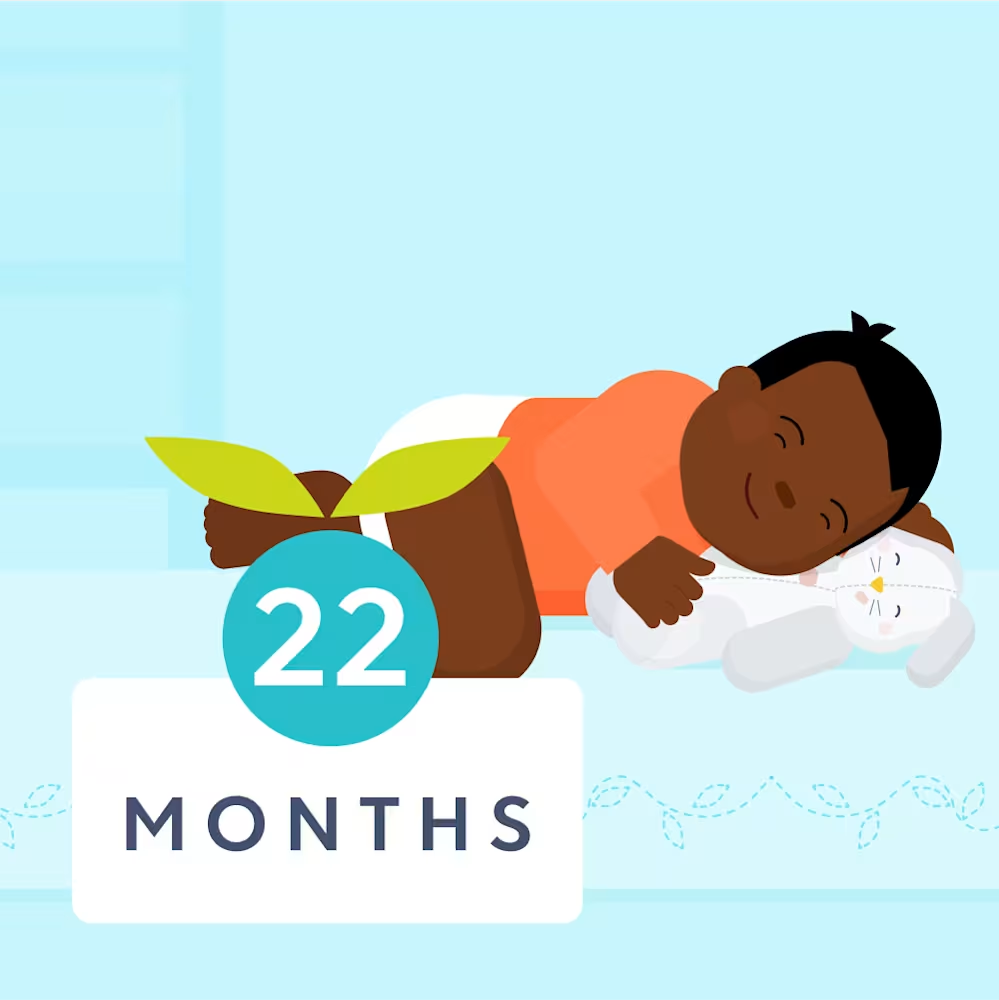22 month old toddler milestones: Development, growth, speech, language, and more
Updated Oct 17, 2025

At 22 months old, it may feel hard to believe how close your little one is to their second birthday. Yet, at the same time, it may also feel like you’ve already been wrangling a feisty 2-year-old for months.
In addition to those “terrible 2’s” mood swings and temper tantrums (that are developmentally appropriate at this age!), other typical milestones at 22 months often include persistence in trying to achieve tasks independently (as well as the motor-planning skills needed to eventually accomplish them!), learning self-control, an expanding vocabulary, and using their imagination. In this article, we’ll take you through the milestones that toddlers often reach between 22 - 23 months, including speech, language, emotional development, and new motor skills. We’ll also give you a handy 22 month old development checklist and useful tips to support your little one’s growth.
Editor's note
When we discuss children and development at Huckleberry, we use their adjusted age (vs. actual age). Not all kids will reach 22 month old milestones at the same time — and that’s normal. There’s a wide spectrum when it comes to how fast toddlers grow and develop. While many kids do reach these milestones between 22 - 23 months, this isn’t always the case. If you have any concerns or questions about your child’s development, reach out to their pediatrician.
Table of Contents
22 month old toddler milestones at a glance
At one year and ten months, you can expect changes in overall behavior and development patterns as your toddler broadens their skills.
Development:
At 22 months old, there’s often progress in your toddler’s communication, with some starting to say as many as 50 - 100 words by their second birthday []. Along with this expanding vocabulary, 22 month olds are also often learning how to use their words to more effectively express themselves, with some putting two words together to form their first sentences (e.g. “go down” when they want to be put down). They're also developing new fine motor abilities and attempting new things — themselves. These curious little ones learn by intentionally watching others around them and are eager to do things without your help. Along with this inquisitive streak and the quest for independence typically comes boundary-testing and pushing limits. While potentially frustrating for you and your kiddo at times, this is all part of normal toddler development.
Sleep:
22 month olds are typically able to stay awake for longer periods but typically still need one solid nap to be sufficiently rested. At this age, we recommend aiming for at least per day (including an afternoon nap) — this may look like at least 10 - 12 hours of nighttime sleep and 1.5 - 2.5 hours of daytime sleep. Aim for a consistent bedtime that will usually allow 5.5 - 5.75 hours of awake time before bed.. Even if your little one goes through a sudden period of challenging sleep and starts fighting naps, most children aren’t developmentally ready to drop that last nap until at least 3 years old. Continue to offer a daily nap, even if your child fights it sometimes, and aim to keep your pre-sleep routines consistent during any regressions.
It’s not uncommon for toddlers to experience disrupted nighttime sleep around this age due to various factors like , changing sleep needs, big life changes, separation anxiety, and overtiredness (thanks to those nap strikes). 22 month olds may also be teething or getting sick as they play more with other kiddos, and this discomfort can lead to sleep challenges as little ones need some extra comfort (especially at night).
If you’d like personalized sleep guidance for your toddler, especially as you navigate schedule changes and possible nap or bedtime resistance, consider submitting for a sleep plan through. Our step-by-step plans are tailored to your child’s needs as well as your family’s goals.
Feeding:
It may feel like your 22 month old is a snack machine but has no appetite for meals. Although frustrating for caregivers, is common around this age — and can stick around until they’re around 4 years old []. It’s also developmentally appropriate (and equally confusing) for your 22 month old to suddenly refuse foods (even favorite foods!) and to have an inconsistent appetite.
Despite these varying hunger levels, it’s normal for 22 month olds to eat roughly five times a day. This often looks like per day. If your little one has entered a picky phase, try not to let that influence what you serve. Instead of defaulting to the “safe” foods they’re the most likely to eat, continue offering a variety of tastes and textures without worrying about how much they’re actually eating each meal. Your toddler may eat a lot during one meal but not much the next. This variation is normal and their intake usually evens out over a week or so.
22 month developmental milestones
Physical development at 22 months
Gross motor milestones
22 month old toddlers are typically on the move — and not just running, but often starting to look more coordinated while they do []! Between now and their second birthday, you can also expect little ones to climb stairs (while holding the railing), use their feet to move on a riding toy, kick a ball forward, and jump in place or forward. Between 19 - 24 months, toddlers also typically learn how to climb on low furniture, stand on their tiptoes, and pull toys behind them while walking []. You can also expect your 22 month old to work on skills like throwing a ball forward, trying to catch a ball (with their arms or body, without losing balance), and squatting during play [].
Don’t worry if your 22 month old hasn’t conquered all these athletic quests. You can expect most kiddos to master these large body movements by their second birthday, but keep in mind that not all kid will develop them at the same time []. There’s a wide range of normal when it comes to toddler milestones, including gross motor skills. However, check in with your child’s healthcare provider if they’re not taking independent steps yet, haven't developed a mature heel-toe walking pattern after several months of walking, walking exclusively on their toes, or aren't speaking more than 15 words [].
Fine motor milestones
You can expect your 22 month old to be using their hands and fingers as they look for more independence, from starting to feed themselves using a spoon [] or fork [] to turning the pages of a book on their own, flipping light switches on and off, and helping dress themselves []. Many toddlers are also exploring their budding artistic talents around this age and can use pens, markers, or crayons to scribble or make marks on paper [], fold paper (if you show them how), and make shapes with clay.
At 22 months, kiddos are also often inquisitive and use their hands to learn more about how things work from trying different knobs and buttons [], taking toys apart and putting them together again [], and pulling apart connecting blocks []. As toddlers near their second birthday, you can also expect to see them sorting shapes and colors, stacking up to 5 - 6 blocks [], and being able to do a 3-piece puzzle [].
Speech development
Language skills: 22 month olds typically use at least 50 words [] and consistently imitate new words as they continue learning from (and mimicking []) what they overhear around them. By 22 months, toddlers can also often name familiar objects and pictures, use 2-word phrases, and follow 2-step directions. Little ones this age may also understand action words and simple pronouns (e.g. me, you, my). Although it may not seem like it, your little one is constantly adding new words to their vocabulary around this age. Between 18 - 24 months, toddlers typically go through a period of “language explosion [],” where they rapidly absorb new words faster than they can say them. During this time, kiddos often can understand more words than they speak, and may surprise you with what they comprehend — or repeat — so you may want to watch what you say around them!
Language “approximations”: As toddlers approach 22 - 23 months, they may know between 50 - 100 words [], but they may not know exactly how to pronounce them just yet. Parents commonly overhear creative takes on words like “duh” for dog, “aminal” for animal, “guck” for truck, or “cool” for school. These mispronunciations may make it harder for others outside your family to understand them, but they’re expected and developmentally normal. Mispronunciations at this age are also a good sign, indicating that you have an active listener on your hands and they’re eager to try out the new words they’re learning.
Overgeneralizing: As toddlers approach 22 - 23 months, they often use one word to convey many meanings. Or, they may start taking one word or grammar rule they’ve learned and broadly applying it. For example, toddlers this age may know that the adult female in their life is “mama” and start using the term to describe other adult women around them — even strangers at the grocery store. Even if your 22 month old uses “dada” for other men or your pet’s name for other animals, they know the difference. It's not that they think other adults are their mom or dad; it's just that they are still learning to sort and label people and objects. And although it may feel slightly embarrassing in that moment if your kiddo calls a random person they see “mom” or “dad,” this overgeneralizing phase is common and temporary. It’ll probably make for a good laugh!
Getting good at gestures: Many 22 month olds have discovered the power of the pointer finger and understand they can use it to communicate things of interest []. Toddlers this age may also be working on getting the hang of other gestures outside of pointing and waving, like blowing a kiss, nodding “yes,” or shaking their heads “no" []. As their language comprehension grows, you can expect to see kiddos using these gestures in pretend play []. Toddlers this age may also be able to point to a range of familiar people, food, or objects, 3 - 5 body parts, and specific objects in a picture when named for them [].
Social development
Mood Swings: It may feel like your 22 month old hit the “Terrible Twos” early! However, unpredictable mood swings are common at this age (and for a while longer) []. That’s because toddlers are learning new skills that allow for greater independence while, at the same time, they’re better understanding they’re a separate individual from you (which can be scary). 22 month olds are also still figuring out how to effectively communicate what they want — and how to cope with frustration when they don’t get it. Trying to navigate these sudden shifts may feel like they’re giving you whiplash: your toddler may go from an independent explorer who’s eagerly trying to do everything for themselves. The next moment, they may be a clingy kiddo, needing extra cuddles and insisting on being carried by you.
Understanding feelings: At this age, toddlers typically learn about their own feelings and what these different emotions mean []. However, although 22 month olds may understand “no” and realize they don’t like how that feels or get frustrated when they can’t do something themselves, they’re still working on self-control. Toddlers are learning what to do with these emotions (and their actions) in these moments of big feelings.
As toddlers near their second birthday, they also typically become more aware of others’ feelings — even if they don’t quite understand them. Kiddos this age begin to develop empathy and may begin to notice when someone is hurt or upset []. They may pause or look sad in response, or look to you to see how you react..
Being Possessive: 22 month olds are typically learning the concept of “mine!” []. At the same time, they often have little awareness of their actions and the impact they have on the feelings of others. They also don’t quite get the idea of sharing [] just yet and still tend to view themselves as the center of the world []. This contributes to playdates getting physical as toddlers compete for toys and assert ownership of their items. This period of possessiveness over their belongings may help toddlers feel like they have some control over their rapidly changing world. And it won’t last forever! In fact, this streak signifies thinking and emotional development: They’re becoming more self-aware which is the foundation for important emotions including empathy, self-confidence, and pride!
22 month milestone checklist
The following is a general checklist of milestones toddlers may reach by 22 months. All toddlers are unique and there's a spectrum of normal milestones at this age. However, if you’re concerned about your 22 month old’s growth or developmental delays, contact their healthcare provider.
Milestones to watch for at 22 months:
Uses simple phrases (18 - 24 months) []
Uses two- to four-word sentences
Follows simple instructions
Begins make-believe play
Sorts objects by shapes and colors
Eats with a spoon (19 - 24 months) []
Starts to jump with both feet leaving the ground
Climbs on low furniture
Walks up and down stairs (with support)
Kicks large ball
Runs
Stands on tiptoes
Can pull toys behind them while walking alone
Flips switches on and off, turn knobs, and press buttons
Scribbles
Stacks 5+ or more small blocks or toys
Takes toys apart and puts them back together
Follows two-step directions
Consistently imitates new words
Identifies 3 - 5 body parts when named []
Uses at least 50 words []
Understands and uses simple pronouns (me, you, my)
Uses words and gestures during pretend play
Points to objects of interest
Uses both hands equally
Transitions from toe walking to heel-to-toe walking pattern
What are 22 month development red flags?
Every toddler develops at their own pace, but some signs may need closer attention from a healthcare provider. Reach out to your doctor if your 22 month old []:
Isn’t pointing
Isn’t walking
Doesn’t show or share objects to others
Doesn’t understand how to use everyday (like a fork or brush)
Doesn’t try to mimic others' actions
Doesn’t say at least six words or isn’t learning new words
Doesn’t react when a caregiver leaves or comes back
Loses skills they previously had
If you have any concerns about your toddler’s development, it’s always best to check with their pediatrician. Trust your instincts — you know your child best.
3 development tips for 22 months
Tip #1: Translate for them often
As your 22 month old confidently uses their vocabulary, they may have nailed the meaning of words but still need some help with the execution. Mispronunciations are expected during this period of language development as toddlers learn how to express themselves. However, you can help your little one (and those around them)by being their translator []. The more your toddler hears — and speaks for themselves — the better it is for their speech development.
If your toddler is talking and someone is having difficulty understanding, let your kiddospeak first. Then repeat back what they’re trying to say and model the correct pronunciation — to clarify for the other person and to model for your little one. For example, “Emma, you said you read that book in school, right?” Then, try to repeat the word again, “At school they read a ton.” Repetition, along with practice, helps kiddos learn new words as well as how to pronounce them correctly.
Tip #2: Reset mealtime expectations
Inconsistent eating comes with the territory at this age, which can be a challenge for parents. We know it can be stressful when your little one eats a ton one day and seemingly nothing the next. Or goes from being an endless blueberry pit to suddenly refusing to eat them. However, instead of focusing on how much they eat at each meal or pestering them to eat more, aim to keep family meals pressure-free. As much as possible, go into meals with the expectation that appetites often vary at this age (and that’s normal!).
To help keep the stress low, try the approach. With this strategy, parents choose what food to serve — and it’s up to their child to decide how much to eat from the foods offered. Not only does this division of responsibility help keep family meals pleasant, but it also allows your child to work on developing good habits, feel empowered around eating, and continue creating a healthy relationship with food now and in the future. It’s often easier said than done — we know! — but keep in mind picky eating is typically a phase and it won’t be this way forever.
Tip #3: Encourage pretend play
At 22 months, toddlers are starting to use imagination more. Offer simple props like toy phones, cups, or stuffed animals and join in their pretend scenarios. This helps boost creativity, language skills, and problem-solving while strengthening your bond.
Activities for a toddler at 22 months
1. Change the game
At 22 months, your little one may be a pro at stacking up to 5+ blocks (or at least knocking over yours!). But as they continue to work on block stacking, slightly change the game and focus on building too []. Whether you use blocks, magnetic tiles, Legos, cups, or any other building objects, encourage your little one to explore their imagination. Not only does building (and demolition) foster pretend play, but it also improves those fine motor skills. As they build castles, buildings, animals, or anything else they envision, cheer them on again and again. Playtime is also a great opportunity to talk about other details that will aid in learning, so aim to get specific with that praise. Instead of generic phrases (e.g., “ Wow great job!"), aim to include details as you shower them with positive reinforcement. For example, something like "Great job adding those red blocks on top of the blue ones," gets some language about color into playtime. While, "Nice work stacking these cubes. Let's count how many there are," gets some math language in.”
2. Tag in a doll
You can also help your 22 month old reach new milestones by welcoming an extra playtime pal, like a doll or favorite stuffed animal []. With this new friend, you can practice naming body parts on all three of you and turn it into a pointing game. Verbal repetition helps with language development, while the visual encourages comprehension.
For example, “This is mommy’s elbow, Dolly’s elbow, and Jack’s elbow. Jack, where’s Dolly’s elbow?” You can also play back-and-forth games between the three of you to help her understand taking turns and practice sharing. A doll also allows kiddos to play pretend and imitate what they see others doing, including practicing new skills like brushing their hair or teeth and “reading” them a book. They can also work on following 2-step directions at the same time (e.g. “Give Dolly the red ball” or “Put Dolly’s pacifier in her mouth.”).
Caring for a sick 22 month old
When your toddler isn’t feeling well, it can affect their energy, appetite, and sleep. These strategies can help make them more comfortable while they recover:
Hydration is key: Sick toddlers may eat less, so focus on keeping them hydrated with small, frequent sips of water, milk, or other age-appropriate fluids.
Clear congestion: A blocked nose can make eating and sleeping harder. Use saline drops, gentle suction, or a cool-mist humidifier to help your toddler breathe easier, especially before naps and bedtime.
Track fevers: Reach out to your pediatrician if a fever lasts over 24 hours or spikes above 104°F (40°C) repeatedly []. With doctor approval, infant or children’s Tylenol or Motrin may be used. Avoid over-the-counter cold medicines — they aren’t safe for toddlers.
Adapt sleep routines: Illness can disrupt regular sleep. Your child might nap more, nap less, or wake up more often at night. Follow their cues and resume your usual schedule once they’re feeling better.
Provide comfort: Some toddlers want extra cuddles, while others need a little space. Pay attention to their signals and respond accordingly. Remember, caring for a sick toddler can be exhausting — don’t hesitate to get help when you need it.
When to seek help
If your child has a fever for more than 24 hours or it reaches above 104°F (40°C), call their doctor right away. These can be signs of a more serious infection or illness and it's best to rule out anything that needs medical attention.
In general, if something feels off or you’re worried about how your child looks or acts, it’s safest to check in with their doctor. And if you already talked to them but symptoms appear worse, that’s a good time to check back in too.
Takeaway
22 month olds are often learning physical skills like how to run with more coordination, kick a large ball, and walk up upstairs (with support). You can also expect little ones in this age range to start jumping with both feet leaving the ground, squatting during play, engaging in pretend play, throwing a ball forward, and trying to catch a ball (with their arms or body). They may say as many as 50 - 100 words [] and be going through a “language explosion” where they’re rapidly comprehending new words — even if they can’t speak them yet.
We recommend aiming for around 12.5 hours of total sleep per 24 hours to be sufficiently rested. This often looks like 1 midday nap that’s 1.5 - 2.5 hours and 10 - 12 hours of overnight sleep.
It’s common for 22 month olds to be pickier eaters with inconsistent appetites. Despite their fickle eating habits, they typically need three meals and two snacks per day (whether they eat them or not). Keep in mind that it’s normal to see bouts of picky eating and/or an inconsistent appetite at this age. Bring up any concerns about your child’s eating habits with their healthcare provider.
There’s a wide range of what’s considered “normal” when it comes to 22 month milestones. As toddlers approach their second birthday, they won’t all be on the exact same developmental timeline and it's OK if your little one hasn’t mastered all of these skills just yet. However, always listen to your gut and contact your child’s healthcare provider if you notice any concerns, developmental red flags, or delays.
22 month developmental milestones FAQ
Share article:
Note: The content on this site is for informational purposes only and should not replace medical advice from your doctor, pediatrician, or medical professional. If you have questions or concerns, you should contact a medical professional.
12 Sources
Table of Contents
Share article:






